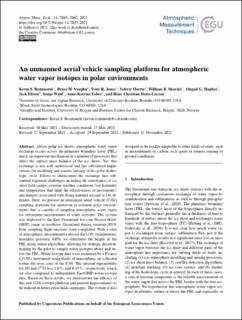| dc.contributor.author | Rozmiarek, Kevin S. | |
| dc.contributor.author | Vaughn, Bruce H. | |
| dc.contributor.author | Jones, Tyler R. | |
| dc.contributor.author | Morris, Valerie | |
| dc.contributor.author | Skorski, William B. | |
| dc.contributor.author | Hughes, Abigail G. | |
| dc.contributor.author | Elston, Jack | |
| dc.contributor.author | Wahl, Sonja | |
| dc.contributor.author | Faber, Anne-Katrine | |
| dc.contributor.author | Steen-Larsen, Hans Christian | |
| dc.date.accessioned | 2022-03-22T07:09:15Z | |
| dc.date.available | 2022-03-22T07:09:15Z | |
| dc.date.created | 2021-11-11T12:18:57Z | |
| dc.date.issued | 2021 | |
| dc.identifier.issn | 1867-1381 | |
| dc.identifier.uri | https://hdl.handle.net/11250/2986673 | |
| dc.description.abstract | Above polar ice sheets, atmospheric water vapor exchange occurs across the planetary boundary layer (PBL) and is an important mechanism in a number of processes that affect the surface mass balance of the ice sheets. Yet, this exchange is not well understood and has substantial implications for modeling and remote sensing of the polar hydrologic cycle. Efforts to characterize the exchange face substantial logistical challenges including the remoteness of ice sheet field camps, extreme weather conditions, low humidity and temperature that limit the effectiveness of instruments, and dangers associated with flying manned aircraft at low altitudes. Here, we present an unmanned aerial vehicle (UAV) sampling platform for operation in extreme polar environments that is capable of sampling atmospheric water vapor for subsequent measurement of water isotopes. This system was deployed to the East Greenland Ice-core Project (EastGRIP) camp in northeast Greenland during summer 2019. Four sampling flight missions were completed. With a suite of atmospheric measurements aboard the UAV (temperature, humidity, pressure, GPS) we determine the height of the PBL using online algorithms, allowing for strategic decision-making by the pilot to sample water isotopes above and below the PBL. Water isotope data were measured by a Picarro L2130-i instrument using flasks of atmospheric air collected within the nose cone of the UAV. The internal repeatability for δD and δ18O was 2.8 ‰ and 0.45 ‰, respectively, which we also compared to independent EastGRIP tower-isotope data. Based on these results, we demonstrate the efficacy of this new UAV-isotope platform and present improvements to be utilized in future polar field campaigns. The system is also designed to be readily adaptable to other fields of study, such as measurement of carbon cycle gases or remote sensing of ground conditions. | en_US |
| dc.language.iso | eng | en_US |
| dc.publisher | Copernicus Publications | en_US |
| dc.rights | Navngivelse 4.0 Internasjonal | * |
| dc.rights.uri | http://creativecommons.org/licenses/by/4.0/deed.no | * |
| dc.title | An unmanned aerial vehicle sampling platform for atmospheric water vapor isotopes in polar environments | en_US |
| dc.type | Journal article | en_US |
| dc.type | Peer reviewed | en_US |
| dc.description.version | publishedVersion | en_US |
| dc.rights.holder | Copyright Author(s) 2021 | en_US |
| cristin.ispublished | true | |
| cristin.fulltext | original | |
| cristin.qualitycode | 1 | |
| dc.identifier.doi | 10.5194/amt-14-7045-2021 | |
| dc.identifier.cristin | 1953650 | |
| dc.source.journal | Atmospheric Measurement Techniques | en_US |
| dc.source.pagenumber | 7045-7067 | en_US |
| dc.identifier.citation | Atmospheric Measurement Techniques. 2021, 14 (11), 7045-7067. | en_US |
| dc.source.volume | 14 | en_US |
| dc.source.issue | 11 | en_US |

